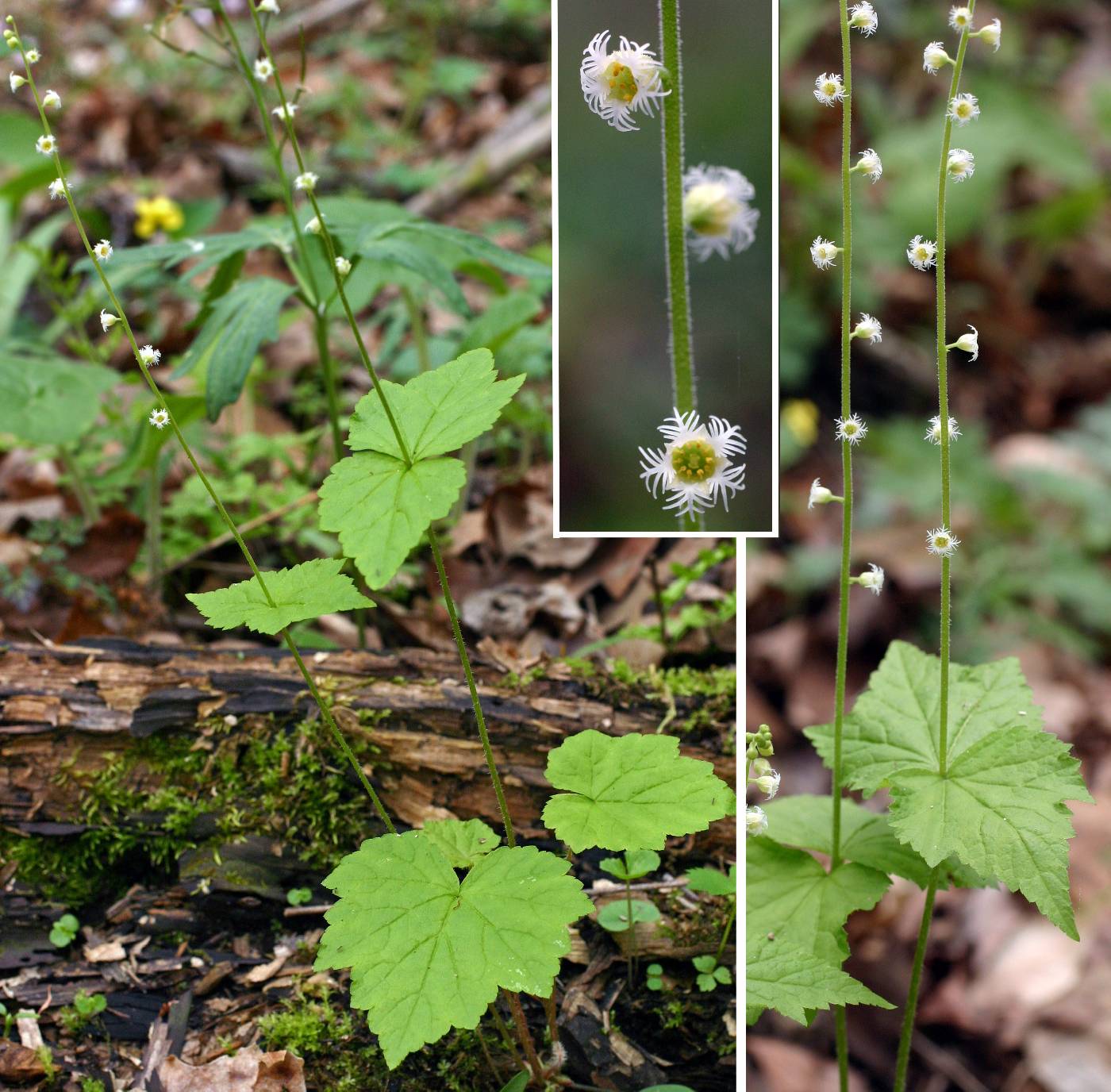Mitella
|
Family: Saxifragaceae |
Herbs, rhizomatous, stoloniferous or not; caudex not cormlike, usually with persistent leaf bases. Flowering stems ascending or erect, leafy or leafless, (2-)6-55(-65) cm, subglabrous or short to long stipitate-glandular. Leaves in basal rosette and cauline; cauline leaves absent or 1-3, alternate or opposite; stipules present; petiole present, sometimes absent in cauline leaves, subglabrous or stipitate-glandular; blade ovate, cordate, or reniform, usually shallowly lobed, rarely unlobed, base cordate to truncate, margins crenate to dentate, apex acute, obtuse, or rounded, surfaces glabrous or subglabrous to variously stipitate-glandular; venation palmate. Inflorescences racemes, terminal from axillary buds in rosette, (scapose or leafy, anthesis usually acropetalous, basipetalous in M. caulescens, not secund to weakly secund or, rarely, strongly secund), 2-60-flowered, sometimes flowers solitary, bracteolate. Flowers: hypanthium adnate ± entire length of ovary, free from ovary to 1.5 mm, green, greenish white, or greenish yellow; sepals 5, white, greenish white, greenish, yellowish green, or greenish yellow, sometimes purple tinged; petals 5, greenish, greenish yellow, whitish green, or white, sometimes pink or purple tinged, (claw slender); nectariferous tissue proximal to stamens absent or obscure; stamens 5 or 10, opposite or alternate with sepals; filaments filiform; ovary nearly superior to nearly completely inferior, 1-locular, (2-lobed), carpels connate ± entire length, (equal); placentation parietal; styles 2; stigmas 2. Capsules obscurely 2-beaked, (dehiscent by adaxial sutures on free, lobed portion, dehiscent fruit sometimes appearing almost circumscissile). Seeds (4-40), reddish purple, dark reddish brown, or blackish, shiny, ellipsoid to ovoid, nearly smooth or pitted. x = 7. Mitella is treated here in the broad sense; phylogenetic data indicate that it is polyphyletic (D. E. Soltis et al. 1990; Soltis and R. K. Kuzoff 1995). Historically, four or five genera have been recognized (including Mitella, Ozomelis Rafinesque, Pectiantia Rafinesque). Formal restructuring of generic boundaries is complicated by the presence of nearly a dozen Asian species (M. Wakabayashi 2001) and lack of a comprehensive understanding of the genus relative to the rest of Saxifragaceae. Mitella nuda and M. diphylla, both with ten stamens, form a clade that would comprise a narrowly defined Mitella. A second clade composed of M. diversifolia, M. stauropetala, M. trifida, and Conimitella williamsii would form a second, distinct genus. Molecular data suggest that M. breweri, M. caulescens, and M. pentandra also form a distinct clade and perhaps a third, distinct genus. The relationships of M. ovalis are less certain; some analyses suggest that it may be sister to the genus Tolmiea (Soltis and Kuzoff; Kuzoff and Soltis, unpubl.). Mitella diphylla exhibits splash-cup seed dispersal similar to Chrysosplenium (D. B. O. Savile 1953). Y. Okuyama et al. (2004) found that four Japanese species of Mitella are pollinated by fungus gnats, the pinnatifid petals of some species providing a resting platform for long- and spiny-legged flies. S. A. Spongberg (1972) reported syrphid flies and short-tongued bees as the most frequent visitors to M. diphylla.
Fls perfect, regular, perigynous, 5-merous; hypanthium turbinate to saucer-shaped, adnate to the base of the carpels; pet narrow, deeply pinnatifid or fimbriate to entire; stamens 10 (in ours) or 5; carpels 2, connate into a 2- beaked, unilocular, superior (to half-inferior) ovary with low-parietal placentas; rhizomatous herbs with basal or alternate, palmately veined lvs from the rhizome, the flowering stems lfless or nearly so, with a terminal bracteate raceme of small white, greenish, or purple fls. 12, N. Amer., e. Asia. Gleason, Henry A. & Cronquist, Arthur J. 1991. Manual of vascular plants of northeastern United States and adjacent Canada. lxxv + 910 pp. ©The New York Botanical Garden. All rights reserved. Used by permission. |

